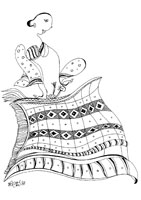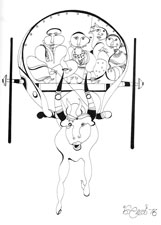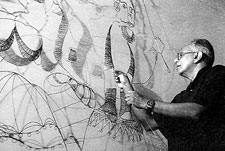After completing my Inter-RIBA, I had no choice but to pursue further studies abroad. While all my colleagues were leaving for Australia and England, I had to choose a country that granted scholarships, as my parents couldn’t afford to fund my higher education. The Italian Government had advertised three scholarships for postgraduate studies and I immediately applied for one. When I went for the interview, I took with me both my architectural work and a portfolio of my line drawings. Within a month I was on a plane to Italy.
 |
I knew little about Italy other than what I had gathered from Roland Silva’s fascinating lectures on the history of European architecture. But I had the most captivating glimpse of Italy from Alberto Moravia’s award winning novel, The Woman of Rome, which I read and relished. Through the women in his book, Moravia gave his readers a ‘sapore di Roma', a taste of Rome. When I read it I never imagined that I would soon be in Rome and spend almost ten years of my life living in the vicinity of the Roman Forum.
I arrived in Rome along with two other Sri Lankans on 15th August, 1971. It was ‘ll Giomo di Ferragosto,’ the hottest day in Italy. I had a strange sensation when I reached the city. The culture shock I experienced was striking, yet fascinating. I sensed something familiar about the place and its people, as if I had lived there before. 15 years later, when I returned to Sri Lanka, a local astrologer examined my palms and told me that in one of my past births I had lived as an artist in Rome and in another birth I had lived during the Sigiriya period in Sir Lanka.
I walked all over this eternal city on my own and discovered spaces with iconic buildings and churches, narrow streets opening out to dramatic vistas and piazzas containing fountains, small and intimate as well as grandiose. I often wandered down the streets, enjoying the glimpses I would catch of the distant hills of Rome. Crossing the Tiber, I suddenly came upon Piazza San Pietro with Bernini’s majestic colonnade and sat on the steps of the Basilica, watching thousands of tourists passing by. It was both enthralling and overwhelming to explore this magical city.
Before long I was on a train to Perugia to study Italian. Both the train trip and the destination - a medieval university town sitting on a hill - almost took me back in history. We were housed for three months in the home of a charming buxom Italian signora. It was at her home that I had my first taste of spaghetti and wine. The house had a panoramic view of the Perugian countryside. At night I could see a stream of lights from vehicles ascending and descending the hillside. It was a completely new experience. There were ten students in all and we were under the care of this wonderful signora who sat with us at mealtimes.
 |
She was ‘la mamma’ to all of us. I hardly acquired the Italian language other than learning how to conjugate a few verbs as I was completely distracted by the foreign girls who had come to study Italian in this university town. Invariably I ended up speaking to them in English. The Arab students in my class teased me saying they were envious as I was with a different attractive foreign girl each time they saw me. The only American in our house, Barbara, a Jewish girl from New York, kindly treated me to a day trip to Florence, about one and a half hours by train. She also took me out to lunch in a fancy restaurant, a luxury I hadn’t experienced before.
Florence had a completely different atmosphere to Rome; it was both smaller in scale and more intimate. Its buildings had textured facades. Here I saw for the first time, Brunelleschi’s magnificent Cathedral, Santa Maria del Fiore. I was just beginning to get a taste of this fascinating country. At the end of October 1971, I left Perugia along with my unsuccessful attempts to learn Italian. I was looking forward to commencing my architectural studies in Milan and simultaneously promoting my line-drawings.
The two years I spent in Milan left a profound impact on me. Here I made the most significant professional connections within the city’s network of architects, designers and photographers. In the 1970’s Milan was the design capital of the world, especially with respect to industrial design and fashion. Milan’s pulse was embodied in its distinct production houses such as Alessi, the international trendsetter for industrial design and Cassina, the premier Italian furniture store. It is no coincidence that the largest international furniture fair, Salone Intermazionale del Mobile was held in Milan each year. Milan was also a thriving centre for the arts, with its multitude of galleries, design stores and publishing houses that produced important magazines and journals on architecture and design such as Domus, Interni and Abitare. Given its potential for innovation, Milan provided fertile ground for radical design movements such as Memphis and nonconformist fashion icons such as Fiorucci to flourish. It was in this environment that I truly nurtured my aesthetic sensibilities.
I arrived in Milan and got in touch with two Italian architects whom I had been introduced to by Cynthia Ai, an art historian I met prior to leaving Sri Lanka. The friendships that I formed with Angelo Mangiarotti and Franco Mirenzi had a pivotal impact on my time in Italy. Mirenzi was an architect and a designer as well as the editor of several leading Italian architecture and design magazines such as Architectura OFX. From the inception of our friendship, he was supportive of my work and in later years he regularly featured my design and architectural work in his publications. Angelo Mangiarotti was an iconic figure in Milan’s design world and was renowned internationally for his ability to establish a rich dialogue between the disparate disciplines of art, architecture, engineering and design. Managiarotti played a crucial role in helping me build a network of contacts in Milan; he connected me to influential architects, photographers and industrial designers.
When I expressed my interest in Italian design, Mangiarotti immediately put me in touch with Bruno Munari. Munari was an acclaimed Italian designer and a prolific author of books on design and art. Munari invited me to his home. His first reaction/seeing my work was to run into the house and bring back an ola leaf manuscript, a gift he had received from a friend who had visited Ceylon. Carefully observing my work, he said, “We have a lot to learn from your part of the world.” This was the inception of a strong bond and artistic collaboration between us.
*********************************************
Architect Tilak Samarawickrema has rarely exhibited his art in Sri Lanka except for two brief appearances in between 1971 and 1983. Samarawickrema spent the intermediary period, his most prolific artistic years, living and exhibiting his work in Rome, Milan and New York.
 |
| Tilak at work: Pic by Sarath Perera |
Since the early 1980’s he has been a major force in the spheres of art, crafts, design and architecture. While the multifaceted nature of Samarawickrema’s career engendered many innovations, his exquisite line drawings—eluded public attention in Sri Lanka. Now the spirit of the art and the artist is captured in his autobiographical book Ink of Lanka.
His art stretches the boundaries of minimalism to its limits. As he casts his characters and the spaces they inhabit, Samarawickrema delineates the barest minimum and leaves the rest to be sketched out in the imagination of the viewer. The late Bruno Munari, the renowned Italian designer, described it thus:
“This curved line of Tilak’s runs over the paper…
The line runs and draws a bullock but not all of it, just enough to be understood, and then runs away to draw a person, but not all, because it must also let you see there is a tree…and above the tree you discover a big bird and the line has already gone away…”
Ink of Lanka vividly and expressively traces Tilak Samarawickrema’s life and work as an artist, providing a retrospective of his artistic sojourns in the 1960’s and 1970’s. This autobiographical volume opens with an introduction by SinhaRaja Tammita-Delgoda followed by Samawickrema’s own reflections on his experiences in Italy and New York, narrated to his daughter Nethra Samarawickrema.
The book has over a 100 drawings and etchings in black and white and colour. These drawings are interspersed with reviews by international art critics and a collection of photographs taken by Samarawickrema of the cultural landscape that inspired his art.
This elegantly crafted 224-paged hardcover book published by Samarawickrema and printed in Sri Lanka by Guneratne Offset will be launched today, November 22 at the architect’s residence and studio.
Ink of Lanka will be available at bookstores at Rs.6,500.
Published here is an extract from the book
|




